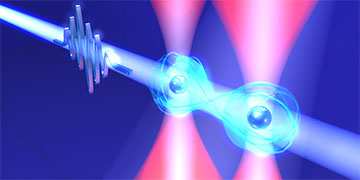
Researchers in Japan have shown how two rubidium atoms held a few micrometers apart and exposed to ultrashort laser pulses can operate as a controlled-Z gate in just 6.5 ns. [Image: T. Tomita]
In the global race to build the first useful quantum computer, devices made from superconducting quantum bits (qubits) and trapped ions are currently leading the way. But new research from scientists in Japan provides hope for a rival scheme involving qubits made from neutral atoms (Nat. Photon., doi: 10.1038/s41566-022-01047-2). They have demonstrated the fastest ever two-qubit logic gate, involving a pair of ultracold rubidium atoms held within a few micrometers of one another by optical tweezers and excited by ultrashort laser pulses.
State of neutral-atom gates
One fundamental challenge in trying to develop quantum computers is the fragility of their quantum states. In principle, neutral atoms make excellent qubits because they can remain in a superposition for longer than other technologies—up to several seconds. However, neutral-atom logic gates have thus far not worked at the speeds that would be needed to ensure operations can be carried out well before qubits decohere, which can occur due to laser noise, thermal radiation or even electromagnetic quantum fluctuations.
Until now, the speed record for a two-qubit gate has been held by Google, which showed in 2020 that it could carry out operations with a superconducting circuit in just 15 ns. Neutral-atom gates, in contrast, have tended to operate at the microsecond timescale. They involve Rydberg atoms, which contain one or more electrons excited to very high-energy states, but they previously relied on a phenomenon known as the Rydberg blockade—which generates very well-defined states but is slow.
Realization of the gate
In the latest research, Kenji Ohmori, Sylvain de Léséleuc and colleagues at the National Institutes of Natural Sciences in Okazaki have turned instead to ultrafast interactions between pairs of Rydberg atoms. They did so by cooling a gas of rubidium-87 atoms down to about ten millionths of a Kelvin and then using optical tweezers to bring atoms within 1.5 to 5 μm of each other. They then shot laser pulses a mere 10−11 s long to excite pairs of adjacent atoms into simultaneous Rydberg states on timescales far shorter than that of the Rydberg blockade.
The excitation knocked electrons from rubidium’s fifth orbital up to the 43rd orbital, yielding huge atoms that underwent dipole−dipole interactions. The result was an oscillation—the exchange of orbital shape and electron energy between the two atoms, with a period lasting just 6.5 ns and ending with a flip in the sign of the electronic wavefunction.
Ohmori and co-workers exploited this phenomenon to demonstrate a type of two-qubit gate known as a controlled-Z gate. This gate flips the quantum superposition of one qubit—from 0+1 to 0−1 or vice versa—if the second qubit is in state 1. State 1 in this case corresponded to an electron being in the 43rd orbital, while for state 0, the electrons were in the original fifth orbital.
The researchers showed that the superposition of the first qubit did indeed only flip when the second qubit was in state 1—thereby demonstrating a two-qubit logic gate with an operation time of just 6.5 ns. According to Ohmori and colleagues, a quantum computer built from such neutral-atom qubits would have “revolutionary potential” as it could be easily scaled up while maintaining long coherence times. The technology, they say, “is attracting attention from industry, academia and government around the world as the next generation of quantum computer hardware.”
Toward practical use
However, the researchers acknowledge that several challenges will have to be met before such two-qubit gates become a practical proposition. For one thing, they say, the commercial laser used to excite the rubidium atoms will have to be replaced with a more stable purpose-built device. They also say that the ultrafast atomic excitation will need to be combined with the encoding of a long-lived qubit in the atoms’ hyperfine ground states.
In addition, the researchers point out that steps will need to be taken to ensure that unwanted quantum states are securely eliminated from the energy-exchange process. But they reckon that techniques developed for other kinds of qubit, such as superconducting qubits or trapped ions, could be applied to the Rydberg atoms. One option would be to fine-tune the atoms’ energies via electric or microwave fields, thereby achieving “synchronization of maximal entanglement and minima of leaks.”
